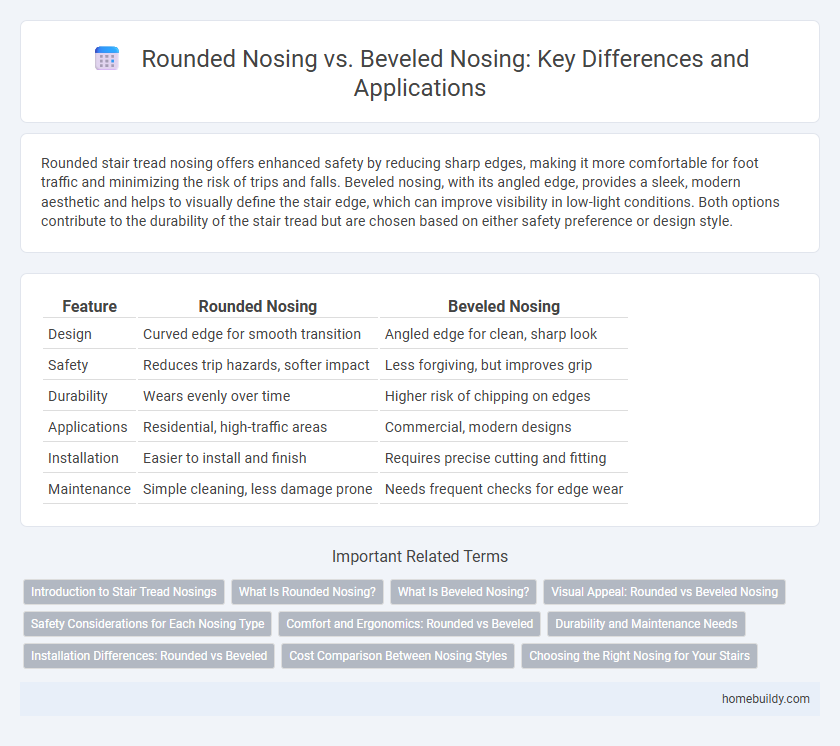Rounded stair tread nosing offers enhanced safety by reducing sharp edges, making it more comfortable for foot traffic and minimizing the risk of trips and falls. Beveled nosing, with its angled edge, provides a sleek, modern aesthetic and helps to visually define the stair edge, which can improve visibility in low-light conditions. Both options contribute to the durability of the stair tread but are chosen based on either safety preference or design style.
Table of Comparison
| Feature | Rounded Nosing | Beveled Nosing |
|---|---|---|
| Design | Curved edge for smooth transition | Angled edge for clean, sharp look |
| Safety | Reduces trip hazards, softer impact | Less forgiving, but improves grip |
| Durability | Wears evenly over time | Higher risk of chipping on edges |
| Applications | Residential, high-traffic areas | Commercial, modern designs |
| Installation | Easier to install and finish | Requires precise cutting and fitting |
| Maintenance | Simple cleaning, less damage prone | Needs frequent checks for edge wear |
Introduction to Stair Tread Nosings
Rounded stair tread nosing offers a smooth, curved edge that reduces wear and enhances safety by minimizing sharp corners. Beveled nosing features a sloped edge that improves traction and visual distinction on stair edges. Selecting the appropriate nosing type depends on factors like foot traffic, staircase material, and safety requirements.
What Is Rounded Nosing?
Rounded stair tread nosing features a smooth, curved edge that enhances safety by reducing sharp corners, making it ideal for high-traffic areas and minimizing trip hazards. This type of nosing provides a comfortable foot grip and durability, often crafted from materials like rubber, wood, or metal for longevity. Rounded nosing also improves aesthetic appeal by offering a softer, more traditional look compared to angular styles.
What Is Beveled Nosing?
Beveled nosing is a stair tread edge design where the front edge is cut at a sharp angle, typically 45 degrees, creating a flat, sloped surface that enhances safety by reducing sharp edges. This type of nosing improves traction and minimizes wear on the tread, making it ideal for high-traffic areas. Compared to rounded nosing, beveled nosing offers a sleek, modern look while effectively preventing trips and falls on commercial and residential staircases.
Visual Appeal: Rounded vs Beveled Nosing
Rounded stair tread nosing offers a softer, more traditional appearance that enhances the visual flow of staircases with its smooth curves. Beveled nosing presents a sharper, modern look by creating crisp edges that emphasize clean lines and geometric design. Choosing between rounded and beveled nosing impacts the overall aesthetic by either promoting warmth and classic elegance or sleekness and contemporary style.
Safety Considerations for Each Nosing Type
Rounded stair tread nosing reduces the risk of tripping by providing a smooth, continuous edge that minimizes sharp corners where users might catch their shoes. Beveled nosing, while offering a sleek aesthetic, can create subtle edges that may increase slip hazards if not paired with anti-slip materials. Safety considerations favor rounded nosing in high-traffic or public areas to enhance user stability and prevent falls.
Comfort and Ergonomics: Rounded vs Beveled
Rounded stair tread nosing offers enhanced comfort and safety by providing a smooth, continuous edge that reduces pressure points on the foot, promoting better weight distribution and minimizing trip hazards. Beveled nosing, with its angled edge, may feel sharper underfoot and can cause discomfort during prolonged use, affecting ergonomic support. Choosing rounded nosing contributes to improved foot placement and reduces strain, making it preferable for high-traffic areas where comfort and safety are priorities.
Durability and Maintenance Needs
Rounded stair tread nosing offers superior durability by evenly distributing wear and minimizing edge chipping, resulting in lower maintenance needs over time. Beveled nosing, while providing a sleek aesthetic, tends to wear faster at the edges, requiring more frequent repairs or replacements. Selecting rounded nosing enhances longevity and reduces upkeep costs in high-traffic areas.
Installation Differences: Rounded vs Beveled
Rounded stair tread nosing requires precise molding and often involves custom fitting to ensure a smooth, curved edge that enhances grip and safety, while beveled nosing typically involves straightforward angled cuts that simplify installation and allow for easier alignment with standard stair dimensions. Installation of rounded nosing demands skilled craftsmanship to achieve a consistent radius, frequently involving adhesive or mechanical fasteners tailored to curved surfaces. Beveled nosing installation prioritizes speed and compatibility with prefabricated components, minimizing cutting time and reducing material waste.
Cost Comparison Between Nosing Styles
Rounded stair tread nosing generally involves more material and labor, resulting in higher installation costs compared to beveled nosing. Beveled nosing offers a cost-effective alternative due to its simpler profile and ease of fabrication. Budget-conscious projects often favor beveled nosing for its affordability without compromising safety or durability.
Choosing the Right Nosing for Your Stairs
Rounded stair tread nosing offers enhanced safety by reducing sharp edges and providing a smoother surface, ideal for high-traffic areas and households with children or elderly individuals. Beveled nosing, characterized by its angled edge, supports contemporary aesthetics and can improve durability by minimizing wear on stair edges. Selecting the right stair tread nosing depends on balancing safety requirements, design preferences, and maintenance considerations to ensure long-lasting performance and stair user comfort.
Rounded nosing vs Beveled nosing Infographic

 homebuildy.com
homebuildy.com